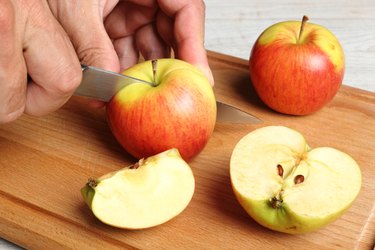
Fruits and vegetables provide a slew of vital nutrients, are low in calories and high in fiber. For some people, however, getting enough fresh fruit in their diets is difficult. Eating fruit, especially in large amounts, has a number of disadvantages. It can upset a sensitive digestive system, cause illnesses from bacteria or create a sugar imbalance.
Indigestion
Video of the Day
Indigestion is associated with a number of uncomfortable symptoms. Bloating, gas, stomach pain, heartburn and nausea often occur as a result of indigestion. You are more prone to indigestion if you have a disorder that affects your digestive system such as gastroesophageal reflux disease or ulcers or if you drink alcohol excessively. Stress and anxiety can trigger indigestion in some people. When you are prone to indigestion, fresh fruits can cause additional irritation to your sensitive stomach. While acidic fruits don't necessarily cause the digestive disorder, eating an orange, apple or grapefruit when your digestive tract is unbalanced can lead to burning sensations in your stomach, bloating that makes you feel full, stomach growling and diarrhea. Fruits high in fiber may cause stomach upset if you begin adding them to your diet too quickly, explains MedlinePlus.com.
Video of the Day
Sugar Imbalance
No one disputes the fact that fruit is a healthy food, but too much of a good thing can be harmful, especially if you have diabetes or other blood sugar problems. Monitor your carbohydrate intake to maintain healthy blood sugar levels, which means monitoring your fruit intake as well. According to the American Diabetes Association, if you have diabetes, a single serving of fruit should contain no more than 15 g of carbs. A half of a banana meets that requirement, while you can eat 1¼ cups of whole strawberries for the same serving. You also can have a ½ cup of cubed mango or ¾ cups of cubed pineapple.
Bacteria
Fruits are exposed to a plethora of bacteria from a wide range of sources. Bacteria such as E. coli, listeria and salmonella attach to fruit from the soil, rain and wind as well as the water used by growers. Many fruits have a tough exterior skin that you don't eat, keeping the bacteria out of your body, but if the skin is broken, that same bacteria easily penetrates the fruit. Eating the skin increases your chance of ingesting bacteria. Fruits with softer skin such as strawberries and grapes, apples, peaches and tomatoes provide a perfect host for many disease-carrying bacteria. Since fruit commonly is consumed raw, it doesn't undergo the heating and cooking process that can kill bacteria and is more prone to causing illness. While washing fruit reduces your risk of getting sick, washing doesn't always remove all the bacteria, according to the University of California.
Availability
Less than one out of every 10 Americans eats sufficient fruit in their daily diets, according to the Centers for Disease Control and Prevention. A diet high in fresh fruit directly correlates with a reduced risk of obesity, cardiovascular disease, diabetes, high blood pressure and even cancer. Fruits are an important source of vitamin C, potassium, fiber, phytochemicals and folate. Unfortunately, fresh fruit is not always available in many communities and can be prohibitively expensive for many people. While frozen and canned fruit make suitable substitutions, they too often contain added chemicals that negate the benefits of eating the food. A report from The Food Processing Center explains that frozen fruit loses a great dea of its vitamin C and nutritional content after being frozen. Nonprofit community groups and educational leaders as well as state, local and federal government agencies all look for ways to increase the availability of fruit to everyone, often with little success.